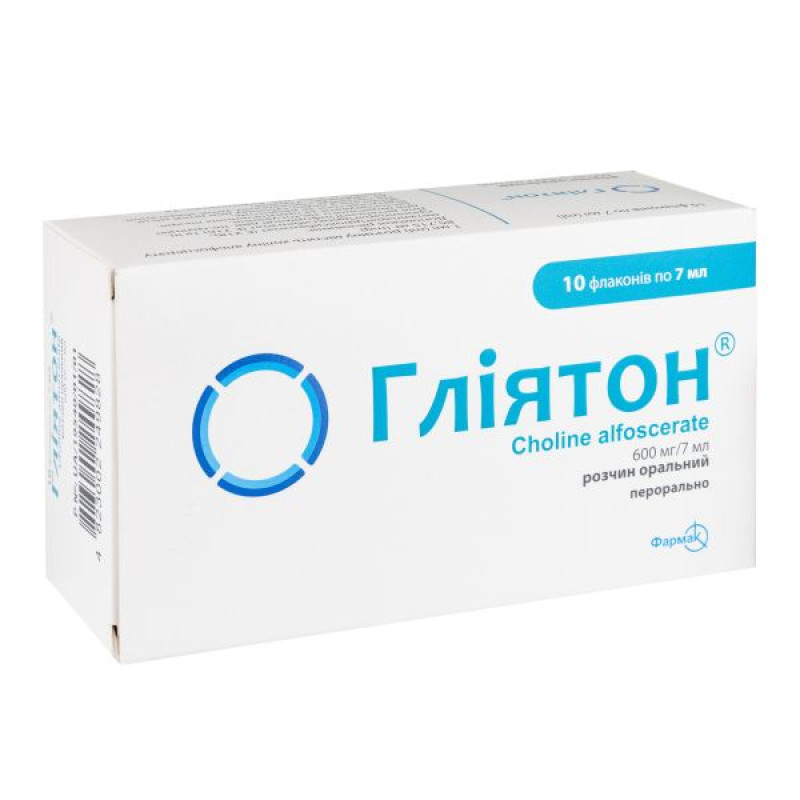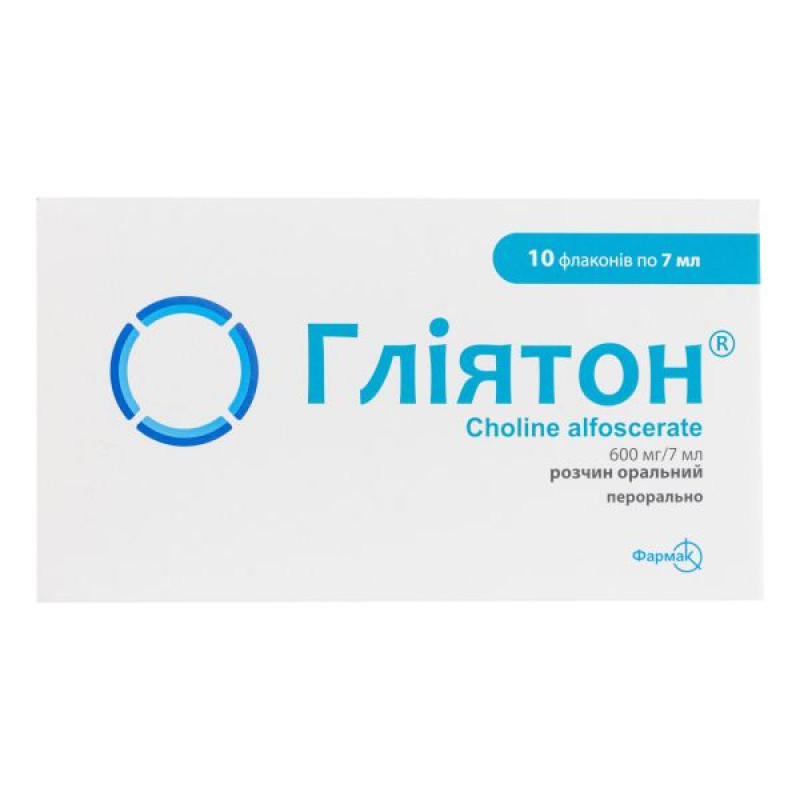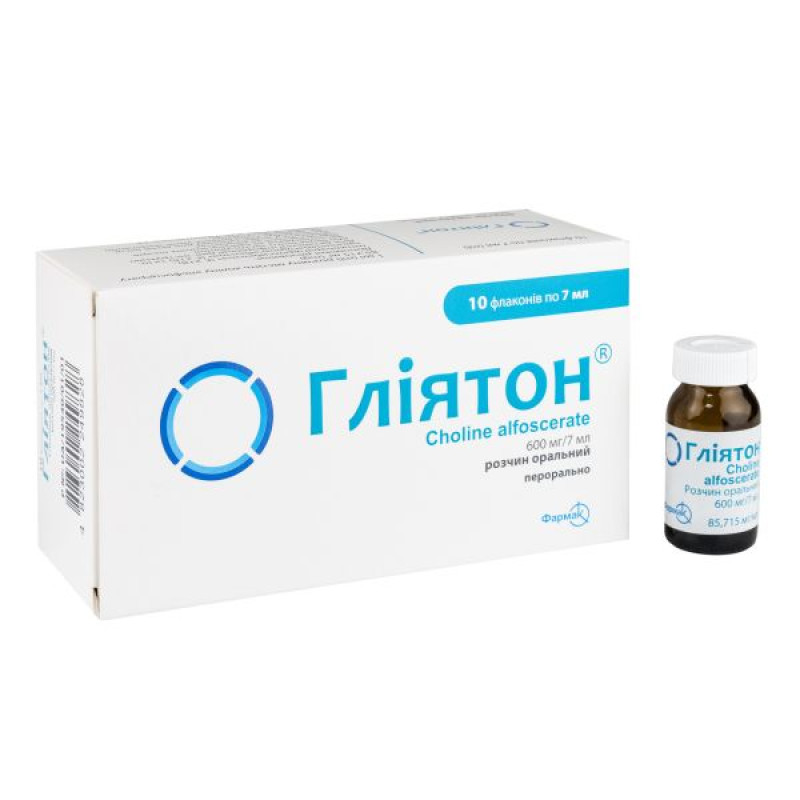Gliaton oral solution 600 mg/7 ml 7 ml No. 10

Instructions Gliaton oral solution 600 mg/7 ml 7ml No. 10
Composition
active ingredient: choline alfoscerate;
1 ml of solution contains choline alfoscerate 85.715 mg;
excipients: methyl parahydroxybenzoate (E 218), propyl parahydroxybenzoate (E 216), sodium saccharin, orange flavoring (aromatic compound, maltodextrin, xanthan gum (E 414), butylhydroxyanisole (E 320)), purified water.
Dosage form
Oral solution.
Main physicochemical properties: transparent, colorless to yellowish solution with an orange aroma.
Pharmacotherapeutic group
Agents affecting the nervous system. Parasympathomimetics. Choline alfoscerate. ATX code N07A X02.
Pharmacological properties
Pharmacodynamics
Choline alfoscerate is a drug that belongs to the group of central cholinomimetics with a predominant effect on the central nervous system (CNS). Gliaton® has a positive effect on memory function and cognitive abilities, as well as on indicators of emotional state and behavior, the deterioration of which was due to the development of involutional pathology of the brain.
Choline alfoscerate, as a choline carrier and precursor of phosphatidylcholine, has the potential to prevent and correct biochemical damage that is of particular importance among the pathogenic factors of psychoorganic involutional syndrome, i.e., it can affect reduced cholinergic tone and altered phospholipid composition of nerve cell membranes.
The composition of the drug includes 40.5% metabolically protected choline, which ensures the release of choline in the brain. The mechanism of action is based on the fact that when choline enters the body, alfoscerate is broken down by enzymes into choline and glycerophosphate: choline participates in the biosynthesis of acetylcholine - one of the main mediators of nerve impulse transmission; glycerophosphate is a precursor of phospholipids (phosphatidylcholine) of the neuronal membrane. Thus, it improves the transmission of nerve impulses in cholinergic neurons; it has a positive effect on the plasticity of neuronal membranes and the function of receptors.
Gliaton® improves cerebral blood flow, enhances metabolic processes in the brain, activates the structures of the reticular formation of the brain, and promotes the restoration of consciousness in traumatic brain injury.
In rodents, the LD50 exceeds 1 g/kg parenterally and 10 g/kg orally. Daily oral doses of 300 mg/kg and 150 mg/kg administered for 6 months to rats and dogs, respectively, did not cause clinical signs of toxicity or changes in hematological, blood chemistry or urine parameters. The drug is not mutagenic or teratogenic and did not alter the reproductive performance of rats and rabbits.
Pharmacokinetics
The drug is rapidly absorbed, on average about 88% of the administered dose of choline alfoscerate is absorbed, rapid distribution in organs and tissues is noted. Penetrates the blood-brain barrier. Gliaton® accumulates mainly in the brain (45% of the drug concentration in blood plasma), in the lungs and liver. Renal excretion is about 10%.
Indication
Psychoorganic syndrome on the background of involutional and degenerative processes in the brain, consequences of cerebrovascular insufficiency or primary and secondary cognitive disorders in the elderly, characterized by memory impairment, confusion, disorientation, decreased motivation and initiative, decreased ability to concentrate. Behavioral and affective disorders in the elderly: emotional lability, increased irritability, indifference to the environment, pseudomelancholia.
Contraindication
Hypersensitivity to the components of the drug.
Pregnancy or breastfeeding.
Patient age up to 18 years (due to lack of data).
Marked psychomotor agitation in patients with psychotic disorders.
Interaction with other medicinal products and other types of interactions
Clinically significant drug interactions with other drugs have not been established.
Application features
Nausea may occur due to dopaminergic activation. Efficacy and safety in children (under 18 years of age) have not been established.
The medicine contains methyl parahydroxybenzoate (E 218) and propyl parahydroxybenzoate (E 216), which may cause allergic reactions (possibly delayed).
Use during pregnancy or breastfeeding
The therapeutic indications of the drug do not include its use during pregnancy. However, special studies have not revealed embryotoxic and teratogenic effects.
Ability to influence reaction speed when driving vehicles or other mechanisms
The medicine does not affect the ability to drive or operate other machinery.
Method of administration and doses
Take 7 ml of oral solution 2 times a day.
Use a single-dose (7 ml) bottle or sachet, or measure 7 ml using a measuring spoon from a multi-dose (70 ml) bottle.
The indicated dose may be increased by the doctor.
There is no experience with the use of Gliaton® in children.
Overdose
Possible increase in the severity of dose-dependent side effects. Overdose may manifest as nausea, anxiety, agitation, insomnia. Treatment is symptomatic: taking adsorbing drugs, including taking activated charcoal. The effectiveness of dialysis has not been established.
Side effects
As a rule, the drug is well tolerated even with long-term use.
At the beginning of treatment, the following side effects may occur: anxiety, agitation, insomnia. These symptoms are transient and do not require discontinuation of treatment, but a temporary dose reduction is possible.
Gastrointestinal: nausea (which is mainly a consequence of secondary dopaminergic activation), abdominal pain.
From the nervous system: short-term confusion (in this case, the dose must be reduced), headache.
From the cardiovascular system: decreased blood pressure.
On the part of the immune system: hypersensitivity reactions: skin redness, rash, itching, urticaria, angioedema.
Reporting of suspected adverse reactions.
Reporting suspected adverse reactions after the marketing authorisation of a medicinal product is an important procedure. It allows for continued monitoring of the benefit-risk balance of the medicinal product in question. Healthcare professionals should report any suspected adverse reactions via the national reporting system.
Expiration date
2 years.
Do not use the drug after the expiration date indicated on the package.
Storage conditions
Does not require special storage conditions.
Keep out of reach of children.
Packaging
7 ml in a bottle. 5 bottles in a blister. 2 blisters in a pack.
Or 70 ml in a bottle. 1 bottle in a pack together with a dosing spoon.
Or 7 ml in a sachet. 10 or 30 sachets in a pack.
Vacation category
According to the recipe.
Producer
JSC "Farmak".
Location of the manufacturer and its business address
Ukraine, 04080, Kyiv, Kyrylivska St., 74.
There are no reviews for this product.
There are no reviews for this product, be the first to leave your review.
No questions about this product, be the first and ask your question.









